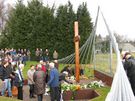The History behind the Monument
On 8 March 1945, two months before the end of the war in Europe, the German SS executed 117 men on the spot where the monument now stands. It was a reprisal for the attack on Hanns Albin Rauter, the Highest SS and Police leader in the Netherlands, at the hamlet "Woeste Hoeve" by a local resistance group. Unfortunately the attack was not meant as an assassination attempt on Rauter. They didn't even know that he was expected to pass on that road. All the resistance wanted was to steal a German truck.
At the time the Netherlands were partly liberated and partly occupied, due to the failed attempt of operation Market Garden. When the battle of Arnhem was lost by the allied forces, the town and the villages around it, were forcefully evacuated by the Germans. The Dutch government in London had called for a national railroad strike, to prevent the German army to use the Dutch railways during the battle of Arnhem. The strike had to go on until the war was over.
As a reprisal, the Germans refused to allow any kind of transport for the Dutch people to go by rail. As there was hardly any other kind of transport possible at the time, hardly any food or fuel reached the towns in the west of the occupied part of the Netherlands.
The winter of 1944-1945 was one of the coldest and longest in recorded history and the result was what was called "the Hungerwinter." In the occupied east of the country the lack of food wasn't as bad as in the west as it was more rural there. Yet because of all the refugees from Arnhem and the growing number of people who had to hide from the Germans, it wasn't easy to get food.
The resistance had to provide food not only for themselves but also for those who were in hiding. When they heard that at a butchery in the neighborhood 3000 kg. of meat was ready for the Germans to pick up, they decided to get it for themselves and their charges.
They would have to pose as Germans to do that and they didn't have a German truck, so they would have to pinch one. They picked a lonely stretch of the road that was frequented by German transport and waited. It was a pitch black night, so they had to go by ear. They let a number of light vehicles pass, but went into action when they heard the deep roar of a heavy truck as they thought.
It turned out to be an open BMW with a couple of officers in it. They ordered the car to stop and the men in it to get out.
Instead the men drew their weapons and a firefight broke out. The driver and the lieutenant were killed, Rauter was seriously injured and played dead.
The resistance men didn't notice that one was still alive and with their one weak light they didn't even recognize Rauter, who was one of the most hated men in the Netherlands at the time. It was Rauter who was the chief promoter of terror in the Netherlands through summary arrests and internment, maltreatment and torture became the norm rather than the exception.
It was also Rauter who introduced a system of reprisals for assaults on Germans and their Dutch collaborators. One killed German equaled ten Dutch victims and one killed Dutch collaborator equaled three Dutch victims. During 1944 when the resistance became more violent, the reprisal numbers rose sharply.
When after three hours the car was discovered by a passing convoy, they found that one of the officers was severely wounded. He was taken to a military hospital and there they found out who he really was. The Sicherheitsdienst (SD) started an investigation and concluded rapidly that it had been an assassination attempt on Rauter.
SS-Brigadeführer Schöngarth, Rauters second in command, took over and is in general held responsible for what happened next. However Rauter was never unconscious and he was consulted by Schöngarth in hospital. The responsibility was just as much that of Rauter as of Schöngarth.
Several SD commanders were ordered to find at least 300 Todeskandidaten, prisoners who were never convicted, but had, as resistance men, forfeited their lives.
In several places in the Netherlands a total of 274 men were executed the next day on 8 march 1945 as a reprisal for the attack on Rauter.
At "Woeste Hoeve" they shot the largest group, a 117 in total. The bodies of the victims were lined alongside the road and passersby were forced to walk by them. Late in the afternoon the bodies were moved to a local cemetery and put in a mass grave.
After the war the grave was opened and the identification started. It was a long process, not all prisoners had been send there under their own name, nor had all been listed by the Germans as having been executed. Even today one of the victims is still unidentified. All we know about him is that he was 1m 73 long, had dark brown hair and perfect teeth.
Rauter survived the war and was captured while still in hospital. He was tried and executed on 24 march 1949.
Karl Eberhard Schöngarth was captured by the British and after investigating his background was charged with the crime of murdering a downed Allied pilot. He was convicted and hanged on 19 may 1946 in Hameln Prison.
back

remembrance in 2012